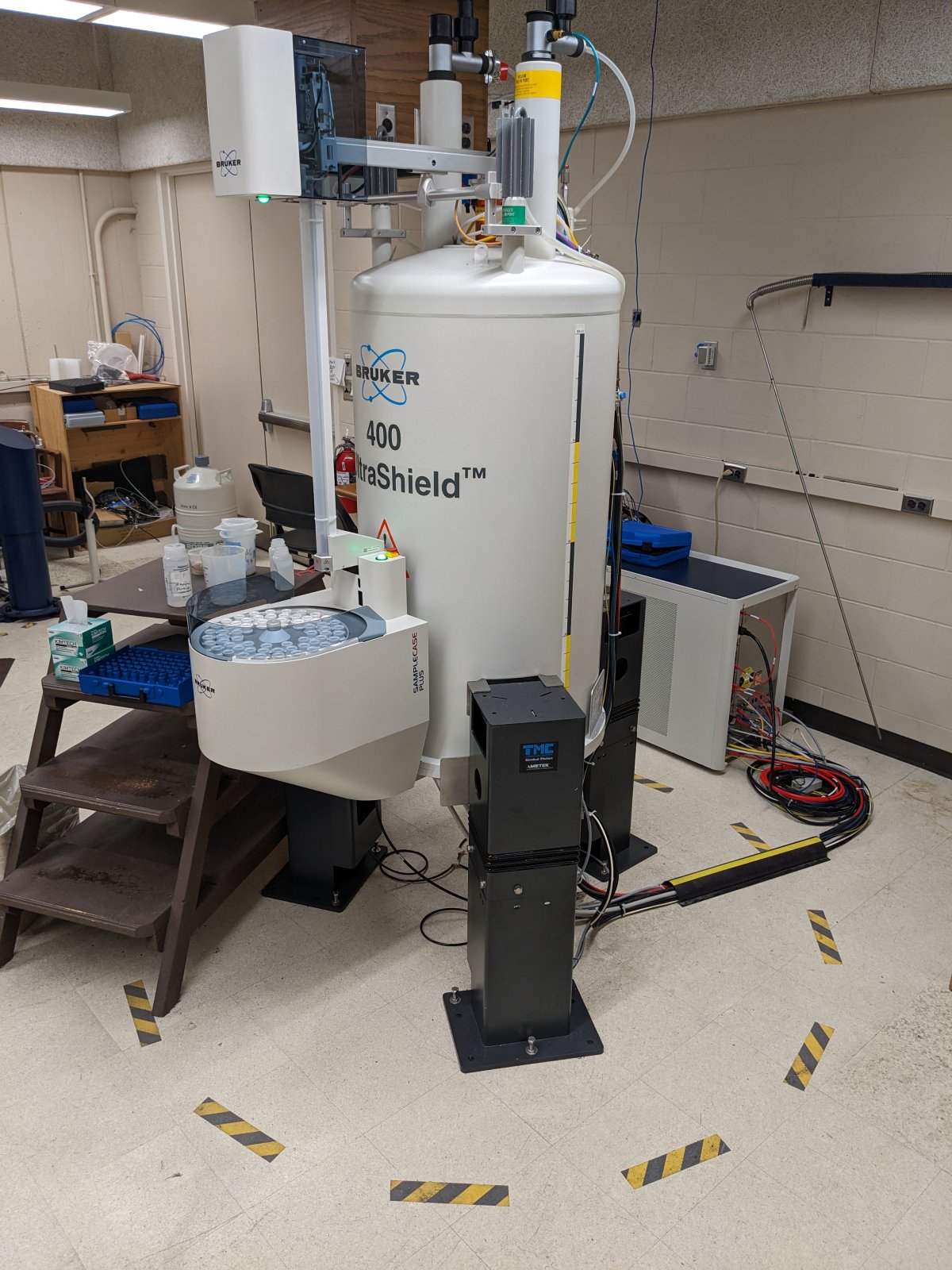NMR Laboratory Safety
Emergencies:
For any emergency, please call 911.
Required personal protective equipment (PPE) for the NMR Laboratory:
- Safety glasses or goggles.
- Long pants. No shorts!
- Closed toe shoes. No sandals!
Broken NMR Tubes/Samples:
If you break an NMR tube outside of a magnet or autosampler, please clean up the mess. There is a broken glass container, broom, and dustpan located near the sink closest to the conference room door.
If you break an NMR tube in the autosampler (e.g. while a tube is in a spinner, the top is accidentally 'sheared' off), please clean up any broken glass and contact the NMR Laboratory director and teaching assistants. If you are comfortable doing so, please remove the spinner with the broken tube from the autosampler and place it in a beaker near the box of spinners--the NMR Laboratory director will remove the broken tube and/or glass from the spinner.
If an NMR tube breaks inside the magnet, please contact the NMR Laboratory director and teaching assistants as soon as possible. The director or TAs will remove the probe and clean it at their earliest convenience to minimize potential damage.
Primary safety concerns:
The NMR Laboratory poses two primary safety concerns: cryogenic liquids and fringe magnetic fields.
Cryogenic Liquids
All of the superconducting NMR magnets housed in the laboratory contain liquid nitrogen (boiling point: 77 K) and liquid helium (boiling point: 4.2 K). Cryogenic liquids present asphyxiation and frostbite hazards. Under normal circumstances, the cryogenic liquids are safely contained within the NMR magnet and these hazards are minimal.
When cryogenic liquids become gases, they expand significantly (upwards of 700-fold increase in volume). In rare circumstances, cryogenic liquids contained inside an NMR magnet can rapidly convert into gaseous form--this is called a magnet quench. Magnet quenches are hazardous as the rapidly generated gas can displace oxygen in the room, presenting an asphyxiation hazard. Here is a video of an NMR magnet quench. If you witness a magnet quench, please calmly exit the NMR laboratory.
When using a liquid nitrogen evaporator accessory for low-temperature NMR experiments, please wear appropriate PPE (consult the UMN EHS Cryogen Guidance Document).
Fringe Magnetic Fields
The superconducting NMR magnets in the laboratory produce strong magnetic fields. Please do not bring metallic objects near the laboratory's NMR magnets.
Any magnetic field extending beyond the outer casing of the magnet is called the fringe field. Magnetic fields are typically expressed in units of Tesla (T) or gauss (G). The US Food and Drug Administration has published guidelines stating that medical devices, like pacemakers, may pose a hazard at 5 G. Users with medical or metallic implants must not enter the 5 G fringe field. Hence, the 5 G fringe field is marked on the floor around the magnets in the NMR laboratory with yellow and black striped tape.
Unshielded superconducting magnets have large fringe fields. For example, an unshielded Oxford 500 MHz magnet has a 5 G line 2.75 meters from the center of the magnet. Modern superconducting NMR magnets have shielding to reduce the fringe field.
All of the superconducting magnets in the NMR laboratory are shielded; although, some have better shielding than others. The HD-500, AV-500, AX-400, and AM-400 magnets are the newest magnets in the laboratory, and consequently, have the best shielding: their 5 G lines are within the legs of the magnet (0.5 to 0.6 m from the center line of the magnet). The NC-400 has the largest fringe field of the magnets in the NMR laboratory at 1 m from the center line of the magnet.
Below, please see photographs of the AX-400 (AM-400 is an identical magnet), the AV-500 (HD-500 is an identical magnet), and the NC-400. Note the yellow and black tape on the floor denoting each magnet's 5 G fringe field.
AX-400, 50 cm 5 G line (below)

AV-500, 60 cm 5 G line (below).

NC-400, 1 meter 5 G line (below).
